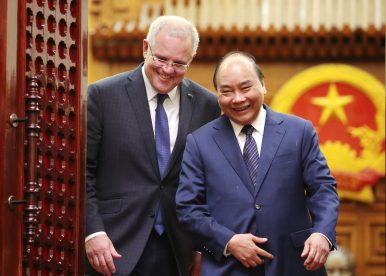By Le Dinh Tinh and Hoang Long
On August 23, Australian Prime Minister Scott Morrison became the first Australian leader to pay an official visit to Vietnam in 25 years.
The visit comes at an important point in time. Global affairs have been gripped by escalating competition between the United States and China in various areas, from politics and trade to defense and technology. The seemingly endless trade war between the U.S. and China has arguably put more strain on already weak global growth and remnants of the volatile recovery from the 2008-2009 financial crisis. High public debt and anti-globalization sentiments are on the rise in different parts of the world. The Fourth Industrial Revolution, while hailed by many, risks widening the technological gaps between nations and sowing division within societies. Transnational challenges such as climate change, food security, protection of the environment and regional flashpoints such as the Korean Peninsula or the South China Sea (which Vietnam refers to as the East Sea) continues to demand for more political will and international cooperation. The global landscape usually comprises positive and negative forces but at its current state is bears more dark shades and unpredictability.
In times of uncertainty, it is not uncommon for friends (and mates this time on) to stick together and Vietnam and Australia showed just that spirit. More than a year ago, Vietnamese Prime Minister Nguyen Xuan Phuc arrived in Australian to elevate relations between the two countries to a Strategic Partnership. Bilateral ties have blossomed in many areas, from politics and trade to education, science and technology, people-to-people exchange, and more since. Trade, for example, increases by 19.3 percent in 2018 compared to the previous year. Two-way investment also looks promising, with Vietnam having 53 projects in Australia and Australia having 458 in Vietnam.
Prime Minister Scott Morrison’s recent visit adds momentum to the developing bilateral relationship. In a joint statement, the two sides spelled out the guiding principles for the bilateral relations for the future.
In trade, the two sides set a target of doubling current investment levels and landing among each other’s top 10 trade partners.The statement also tasked the Vietnam-Australia Economic Partnership Meeting with concrete discussions and implementation. In light of rising skepticism of the benefits of international trade, the two leaders maintained support for the rules-based multilateral trading system with the WTO at its center and hailed free trade mechanisms, particularly the APEC, AANZFTA, CPTPP, and RCEP.
On defense cooperation, Australia affirmed its commitment to supporting Vietnamese peacekeeping forces on the ground via strategic airlift support as well as capacity building programs. The two countries would maintain the annual ministerial-level defence meeting to increase mutual understanding and strengthen cooperation.
Last, but not least, on the issue of the South China Sea, there is criticism that Morrison did not call out China with regard to the stand-off between Vietnam and China in Vanguard Bank and surrounding waters. The two countries’ joint statement, however, in addition to the language commonly found in ASEAN declarations, stressed “serious concerns about developments in the South China Sea, including land reclamation and militarization of disputed features” and “about disruptive activities in relation to long-standing oil and gas projects in the South China Sea.” The joint statement also highlighted the role of the 1982 UNCLOS, particularly the dispute settlement mechanisms and that “concerned parties should respect the decisions made by these mechanisms.” The convergence of the two countries’ views on one of the most strategic and dangerous flashpoints in the world shows a concerted effort to continue to bring the issue to further international scrutiny.
The above highlights of the visit show Hanoi’s view of Australia from four vantage points.
First, as a vibrant and fast growing economy, Vietnam sees Australia as s partner for shared prosperity. Areas where both sides can complement each other include agriculture, connectivity, energy, digital economy. The two countries’ active participation in various FTAs is a strong foundation for increased economic engagement in the future.
Second, as an emerging middle power in a region central to major power competition, it is Vietnam’s long-held view that Australia is a reliable partner to diversify its relations. For Vietnam and indeed many countries in the region, the constructive engagement of Australia and other middle powers are hoped to temper the worst impulses of major countries as competition intensifies. Australia’s readiness to deepen cooperation with Vietnam on strategic issues in defense and security has positive impacts that extend beyond bilateral channels.
Third, as an active and responsible member of ASEAN, Vietnam finds in Australia another important source of promotion for ASEAN’s values such as security, peace, prosperity, safety and freedom of navigation and overflight. With regards to the Indo-Pacific, Australia had offered its own vision of the Indo-Pacific region rooted in stability, peace, prosperity, cooperation, respect for international law, open markets, among others. At the same time, Australia welcomed the ASEAN Outlook on the Indo-Pacific as an “essential” component of regional cooperation.
Finally, Vietnam can learn from Australia’s example in international affairs as a constructive and forward-looking middle power. Middle powers like Australia generally see themselves as promoters of the common good, “bridges” between nations or group of nations and promoters of the values of peace, dialogue, cooperation, adherence to international law and multilateralism, among others. Australia’s efforts to increase North-South cooperation or support of ASEAN’s common position regarding the South China Sea issue are concrete examples.
Vietnam wants to link its values and interests with all partners in the region; enhance its resilience to external shocks and crises, ensure its national interests and overlapping interests; encourage the role of regional and international institutions. The country’s successful hosting of APEC 2017 and the North Korea-U.S. Summit are prime examples of this evolving worldview. As the country gears up for the dual responsibilities of ASEAN Chair 2020 and non-permanent member of the United Nations Security Council for 2020-2021, Vietnam and Australia surely have a lot to discuss with one another.

No comments:
Post a Comment